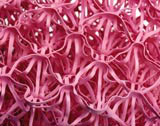A well-crafted plan
As Louise Taylor settles into her role as Crafts Council director, Hannah Booth looks at her ideas for the council’s future and people’s perception of craft

It’s four months since Louise Taylor was promoted to director of the Crafts Council and she’s not wasted any time getting out and about. Smart, intelligent and stylish, she is a great ambassador for craft – vital if she is to succeed in her aim of broadening the appeal of the Crafts Council’s work both in the UK and abroad.
‘We want to break through into the mainstream,’ Taylor says. ‘People have a limited perception of what we are about, and we need to make them see craft as central to our culture. It is starting to happen, though.’
She has just returned from spreading the word from as far afield as north Wales, the Venice Biennale and London’s 100% Design; she opened Manchester Gallery’s new Craft and Design gallery, designed by Casson Ma
nn; and she has just been a judge at the Elle Deco awards.
‘[As director] I have a broader outlook, and am now in a position to actually make changes. We need to be asking the public what it thinks about craft, and ask ourselves why we’re here and what we’re doing,’ she says.
One of the first things she has done is develop a strategy for the organisation for the next five years, which she will be talking about in detail in the spring. But high on the agenda is the Crafts Council’s location. It is currently housed in a ‘glorious’ gun-metal grey listed building in London’s Islington, a touch off the beaten track in a former church with a colourful past, but has out-grown it, she says.
‘Our location doesn’t help us attract a non-specialist audience. We need to remain in London, but more central,’ she says.
The Crafts Council name, too, could come under the spotlight. The 12-year-old, Pentagram-designed logo is ‘a strong brand’ and ‘very recognisable’, Taylor says, but there may be a way to refresh it or attach more meaning to it. And she questions whether the word ‘council’ sounds too administrative and less creative. ‘We’ve got a very exciting job coming up looking at how to project ourselves as dynamic and interesting,’ she says.
Taylor intends to step up the Crafts Council’s partnerships with other organisations. Pilot projects such as Testing Ground, run in collaboration with London Arts, the Royal Society of Arts and the Architecture Foundation, helped give designer-makers time to create new work, and all four partners shared the same goal.
Five years spent at an organisation called Craftspace Touring, prior to joining the Crafts Council as director of artistic programming and information in 1996, gave Taylor a thorough insight into, and excellent contacts in, the regions, not to mention great fundraising experience. Craftspace promoted crafts via tours, shows and joint initiatives, and much of her knowledge can still be applied at the Crafts Council – which was seen as the natural next step in her career.
The council’s international outlook is also important to Taylor. ‘British craft is very well respected abroad for its quality and distinctiveness, and we’ve got individuality in spades,’ she says. ‘But we need more significant international projects for our work, and also need to bring in more foreign exhibitions here, too.’ Its relationships with organisations such as the British Council are ‘very important’ in this respect.
As Taylor says, things are already starting to happen. Events such as last month’s 100% Design, at which the Crafts Council offered bursaries and took on the One Year On programme, are important, but also provide assistance for young designer-makers.
This summer’s hugely successful exhibition, Pattern Crazy, attracted visitors such as families and couples who would not otherwise have stopped by. ‘That’s the job of the summer exhibition,’ Taylor says. Pattern Crazy had a broad appeal similar to that of last year’s summer show, On Paper, she says. ‘Shows with a specific theme, or particular material, work well.’
‘Pattern Crazy was decided in 1999. It was a national exhibition – the result of nationwide studio visits,’ she says.
The latest show is the Jerwood Prize, focusing this year on textiles, which was designed by Gitta Gschwendtner (two shortlisted artist’s work pictured). It is the first time Taylor has worked directly with Gschwendtner on a Crafts Council exhibition, and indicative of her vision to support designers, work with designers outside their usual discipline and mix established designers with newcomers.
‘[Gschwendtner] injected a contemporary quality to the show,’ Taylor says. ‘She has an independent streak, but is highly imaginative. She used embroidered textile banners and, instead of standard portraits of the shortlisted designers, she used a signature and a sketch from each. She create simple, white walls together with areas of red, which some were nervous about,’ she adds.
The Crafts Council works with a broad range of designers, including graphic specialists Agenda, NB Studio and Frost Design to name a few. ‘With print design in particular, we try to use different consultancies for different projects,’ she says.
For now, Taylor is looking forward to the Chelsea Crafts Fair, run in conjunction with the Crafts Council, which kicks off next Tuesday. Longer term, the picture is less settled, but no less exciting.
Louise Taylor’s CV
1988 Graduated from University of Warwick, with a BA in art history
1991 Joined Craftspace Touring as exhibitions co-ordinator. Became director in 1996
1995 Awarded a PhD in design history from Staffordshire University
1996 Joined the Crafts Council as director of artistic programming and information. Promoted to director in June 2002
-
Post a comment




